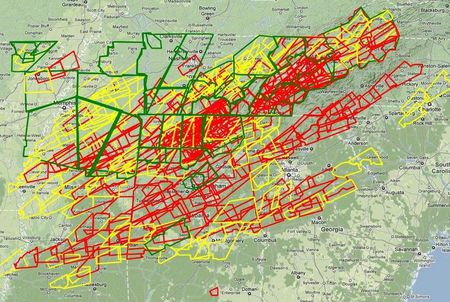Alabama
April 27, 2011: It wasn’t Alabama’s first – or last – tornado super outbreak
Published
5 years agoon
By Lamar Davis 
Editor

ALABAMA – Today marks the 10-year anniversary of the worst day in many Alabamians’ lives: The historic tornado super outbreak of April 27, 2011.
It’s a day most can’t forget — even though they may want to. Sixty-two tornadoes, more than an average year’s worth, tore across the Alabama in just 18 hours on that day.
April 27 was part of a multi-day severe weather outbreak that stretched from the Midwest to the Deep South and even into Canada.
Alabama was one of the states hit hardest: More than 240 died and thousands were injured, according to the National Weather Service.
The storms came in three waves and carved out a damage path of more than 1,200 miles.
April 27 not only changed the landscape — it changed a whole generation that may have thought they had seen it all when it comes to tornadoes.
Because this wasn’t Alabama’s first super outbreak. Not even close.
Another one had come only 12 days before on April 15, 2011, when the state was raked by 45 tornadoes that killed seven people.
Then there’s the 1974 super outbreak, which the National Weather Service called “one of the darkest times in Alabama weather history.” The state was hit by eight tornadoes. Four of them were extremely violent and killed 86 people. The weather service said one tornado nearly wiped the town of Guin off the map.
There was another major outbreak on March 21, 1932, in which at least 15 tornadoes killed more than 300 people in Alabama. The 1932 outbreak had been considered the worst tornado event in Alabama history, according to the weather service.
But all those have been eclipsed by April 27.
And nothing has come close to that day in the decade since.
April 27, 2011, was a rare day. But how likely is it to happen again?
Meteorologists are still asked that question whenever severe weather threatens Alabama.
It can be a hard one to answer.
“For climatology you really need that long-term trend, and you really don’t have that for severe weather,” said Matthew Elliott, the warning coordination meteorologist at NOAA’s Storm Prediction Center in Norman, Okla.
“You can maybe go back 10, 15, 20 years. But beyond that the records become much more unreliable. So it’s hard to get the trends, especially over a 30-year, 20-year period and take much from it.”
He’s not the only one with that opinion.
“Tornado outbreaks are rare, relatively speaking. Especially the big ones that will produce 50 or more tornadoes in one day,” said Dr. Kevin Knupp, a professor of atmospheric and earth science at the University of Alabama in Huntsville.
“They are quite rare, and we just don’t have that many examples of them so we have very little idea of what the climatology of those outbreaks really is.”
But he said it’s fair to say that April 27 was what many have called a “generational outbreak.”
“This event on April 27 was by far the most concentrated event of violent tornadoes that we have seen anywhere. There’s nothing else that would come close to that,” he said. “1974 would be the next one, and that was distributed over a wider area from Alabama into southern Canada.”
The atmosphere ‘on steroids’
There were ominous signs in the forecast at least a week before the April 27 outbreak.
“It was quite obvious from the weather models that April 27 would be a bad day,” Knupp said. “Nobody realized before it all started that it would be as bad as it was.”
As April 27 crept closer the forecast became more troubling.
“About two days in advance I remember just literally being nauseous for about a half day, thinking this is going to be really bad, and are we as the weather service doing enough to let people know?” said Jim Stefkovich, who was the meteorologist in charge at the National Weather Service in Birmingham at the time.
“I’m sure I said it to more than one person, but I was briefing Alabama Power Company, and they said how can you compare this to how big this event’s going to be? And I said this is truly going to be an Armageddon, something you have never seen before,” he said.
Stefkovich described the atmospheric setup on April 27, 2011, as tornado weather “on steroids.”
“It was showing all the classic things you look for … all the right ingredients were on the map right from the start,” said John De Block, the warning coordination meteorologist at the weather service in Birmingham, who also had a front-row view of the storms that day.
“And the day before April 27 when we saw some of the tornado parameter levels we’d never seen before — and widespread across the whole area. All those ingredients that it takes to create severe weather came in place with maximum force all at the same time.”
Even veteran meteorologists weren’t prepared for what happened next.
“We were all probably taught about and learned from the super outbreak of 1974, but I don’t think anything prepares you to deal with a super outbreak. You understand the atmospheric magnitude of it; you don’t understand the societal impact of it when you haven’t experienced it,” De Block said.
“Now having experienced it, now when I see a big event coming, yes, I feel nauseous. Because those of us that have lived through April 27 know what it’s like to have a super outbreak, and none of us wishes to see another one.”
Could it happen again?
April 27 was rare, but was it rare enough that it couldn’t happen again?
“Let’s pray that this doesn’t happen again, but it will,” Stefkovich said.
“It does appear that when you look at large tornado outbreaks it is about a 30- to 35-year time between them,” Stefkovich said. “That doesn’t mean it couldn’t happen again this year or next year. And that’s not to scare anybody, but there’s just no way to say we don’t have anything to worry about for the next 30 or 35 years.”
Knupp agreed.
“I think the chances that we’re seeing the very worst event from the last 50 years are probably small,” he said.
De Block also sees a good chance of another super outbreak at some point in Alabama.
“Yes it will happen again,” he said. “The young children that were around in 2011 will have a high probability of seeing an event like that in Alabama.
“I hate it. I’m not sure I want to be around to see another one. In all likelihood there’s going to be another one. And hopefully the lessons that we’ve learned from April 27 will mean that the next super outbreak is not as impactful especially with the loss of lives and injuries.”
De Block was one of many from the weather service that spent time last month tracing damage from two separate tornado events — March 17, which had 25 tornadoes, and March 25, which had 11.
“In our travels (after the March 17 and 25 storms) I don’t think there was a person that we spoke with that didn’t know it was coming and didn’t do the right thing,” said.
That’s a hopeful sign from one of Alabama’s darkest days.
What’s changed since April 27
A lot has changed in the weather world since 2011.
Meteorologists have turned more to social science to study the warning process and how to make weather warnings more effective.
There have been lots of improvements in technology such as dual polarization Doppler radar and next-generation satellites.
Cutting-edge research is ongoing at UAH at the Severe Weather Institute Radar & Lightning Laboratory (SWIRLL), which came into being after the 2011 outbreak, Knupp said.
“There’s a long way to go. We’re only partway there in understanding tornadoes,” he said.
The weather service offices have also cut down their false alarm rates from pre-2011.
“In Birmingham we really worked hard to lower the false alarm rates. And I think to this day it’s one of the best in the country,” Stefkovich said. “When the weather service issues a warning you better take it seriously because more often than not something’s going to happen.
Social media has grown exponentially, and that and the proliferation of smart phones has made getting warnings easier than ever.
“Make sure you’re getting the warnings,” Stefkovich said. “And that’s the thing I think has really changed since 2011. There’s really no excuse not to get a weather warning.”
The weather service always emphasizes to not be scared, but be prepared.
“One thing that people can do, whether it’s a March 17 or an April 27, is to be prepared and have a plan,” De Block said.
“You’re afraid you’re going to say that too often, but that’s the bottom line. If you’re prepared, if you have a plan, you have helmets, you have shoes, you have flashlights, you have a way to get that information, you have an emergency kit … if you have all that available to you and a good place to go, you are doing everything you can to protect yourself from a tornado of any outbreak, whether it’s small outbreak or a big outbreak. The preparation is the same.”
And don’t wait for there to be another super outbreak on the horizon before you prepare.
“Any violent tornado, any tornado really, has the potential to impact someone’s community and someone’s life and property. Take them seriously and not wait until a super outbreak to start heeding the warnings,” the SPC’s Elliott said.
“Alabama’s a vulnerable place for tornadoes, and you really need to be paying attention. Not afraid, but just have a plan and be ready to act if threatening weather is approaching your area.”




